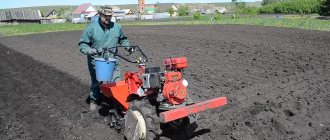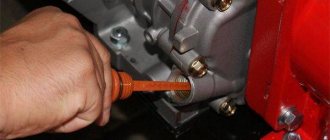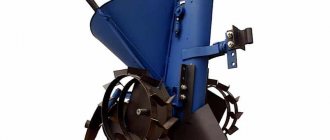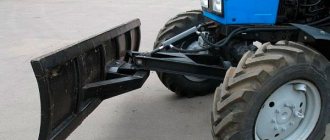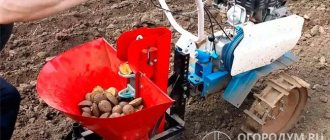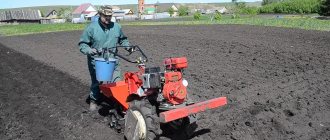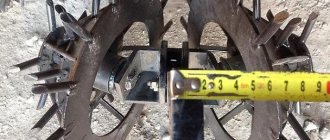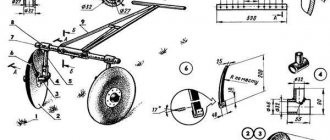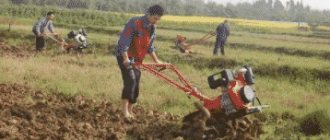Planting potatoes is a difficult task. It takes a lot of effort and time. To make the work of gardeners easier, Russian companies have developed wonderful equipment - a walk-behind tractor. The most famous and popular brands are “Salut” and “Neva”, these are the best walk-behind tractors for cultivating land.
They are easy to operate, last a long time and rarely break down. But there are some rules that must be followed when planting potatoes. This article will tell you tips about proper planting and nuances in using a walk-behind tractor, as well as equipment that will help plant and dig potatoes.
Methods of planting potatoes
There are two planting methods. They differ in the tools they use:
- Hiller with regulator
- Mounted potato planter.
Both options are equally popular among summer residents. It’s just that the first option is used for a small area, and the second for a large area. But the first option is also cheaper. Good for those who like to save money. So, let's look at each of them.
Walk-behind tractor with hiller
Its design consists of the following elements:
- Conveyor is a conveyor that supplies seed.
- Furrower - lays furrows.
- Distributor - with its help, tubers are planted in a strictly specified period of time.
- Hiller - loosens the soil and covers the crop with soil.
This tool works on the following principle. Before you start working, the unit needs to be configured: metal wheels and a special hopper are installed on the tool. Wheels create furrows. They should be even, then the growing process will be simplified.
Potatoes are placed in the hopper, which will fall into the holes when moving. After this, the wheels are replaced from lug wheels to rubber ones and adjusted to the track width. This will prevent damage to the root crop.
Next, the hiller covers the potatoes with soil, compacting it at the same time. Apart from manually adding tubers to the hopper, the entire planting process occurs automatically.
Mounted potato planter
Before using the planter, you will have to carry out the preparatory stage for planting. First you need to plow the land. Then carry out harrowing so that the crop receives the required amount of water and oxygen. After this, you need to moisten the soil (if possible).
This type of walk-behind tractor has the following design:
- furrowers;
- special bunker;
- disk device for filling potatoes with soil.
The structure of the walk-behind hiller allows you to plant potatoes in one go, since the tool simultaneously makes furrows, pours out the tubers and covers them with soil. Before use, you need to attach special wheels to grab the soil and an additional attachment - a potato planter. You can use a homemade unit or buy special equipment.
Using a hiller
Planting potatoes with a walk-behind tractor and hiller is used in small areas. The planting itself is done manually; the walk-behind tractor cuts the furrows. When using a hiller, lugs are installed on the walk-behind tractor.
After landing, the device is replaced with standard rubber wheels. This prevents the potatoes from being damaged when buried.
For convenience, hillers are additionally equipped with mounted planters. This allows you to reduce the cost of human labor.
The unit consists of the following set of accessories:
- Conveyor. The mechanism operates on the principle of a conveyor and delivers potatoes.
- Furrowmaker. Cuts a furrow.
- Distributor. Adjusts the potato feeding speed.
- Disk. Used for hilling. Fills the furrows with soil after planting.
How to plant potatoes with a walk-behind tractor
Pre-landing preparation
Before planting, it is necessary to cultivate the land: plowing and harrowing. Thanks to this, the soil will be saturated with oxygen and it will dry out a little. This is done using a plow or a special cutter.
The beds are crushed (cut) in two ways: using a hand rake or a walk-behind tractor. The choice of tool depends on the area of the site and your own desire. But using the second option is preferable. After all, some tools loosen the soil very well when planting. In this case, the loosening depth reaches 20 centimeters.
It is better to process the area from the edge. First you need to plow 2 meters. After this, you can plow the rest of the area. In order for the depth to be the same everywhere, the plow needs to capture part of the processed bed.
After this, the rows are marked. In order for potatoes to grow better, you need to create free row spacing. The average distance between them should be 60-70 cm. The distance of the rows depends on the type of potato. Various devices are used to create row spacing. After cultivating the soil, you can begin planting potatoes under the walk-behind tractor.
Landing technique
Regardless of how the work is carried out, one rule should be followed. The planting depth should not be less than 10-15 centimeters, and the distance between tubers (seeds) should be 20-30 cm. For ease of orientation, you can pull a rope. Potatoes will germinate better if the soil is fertilized after loosening.
Working with a hiller. First it is attached to the walk-behind tractor. Using the Neva apparatus, you will have to move the blades to increase the wingspan. This is necessary for proper placement of potatoes in the holes. When working with Salyut, you do not have to go through this procedure. The lug wheels are attached to the unit.
The track width of the walk-behind tractor for planting potatoes is 60 centimeters. The tops should be planted at the same distance. After sowing, it is necessary to remove the metal wheels and install rubber ones. In this case, the width should remain the same. The wings are at maximum distance. Now you can cover the crop with soil.
With a large area, it is more convenient, cheaper and faster to plant using a walk-behind tractor with an attached hiller. He plants the potatoes and covers them with soil at the same time.
There is another option for using a walk-behind tractor - using it under a plow. Metal wheels and a plow are simultaneously installed on the apparatus. When planting in this way, it is worth throwing potatoes at the stage of creating a furrow. This must be done immediately, since when the tool creates a new furrow, it covers the seeds in the already created one with soil.
Below you can watch a video on how to plant a plow walk-behind tractor.
Pre-planting treatment of tubers
Pre-planting preparation of root crops requires time and effort. On a standard plot of 6-7 acres, it will take all day to plant it with a shovel, but if you connect the equipment to the work, you can do it in about three hours. For small areas, the Neva, Forza, Sadko, Don, Huter, Champion, and Carver walk-behind tractors are popular.
To begin with, seed material is prepared. Preference is given to regionalized varieties that produce good yields in certain regions. Sorting is done in order to select good raw materials. Potatoes are selected to be the same size.
Small tubers produce a small harvest. Large ones must be cut into pieces, and this provokes various diseases and opens direct access to pests. Germination takes about a month. To do this, the seed material is placed in a warm (+12-15 degrees), bright room.
If dark spots appear on fresh sprouts, this indicates a disease. The affected tubers are thrown away. Before planting, they are soaked in stimulating and pickling substances. It is not recommended to place tubers in the solution for a long time.
It is better to lay them on a flat surface, spray them with preparations and let them dry. You can plant root crops when the ground warms up to +7, +8 degrees (in the planting hole).
Scheme of planting potatoes with a motor cultivator
Before planting potatoes, the soil must be loosened and, at the same time, furrows must be created. Potatoes should be planted at a time when the soil temperature reaches 8-9 degrees. At a depth of 10 centimeters. The furrows should be made as even as possible, and the distance between them should be about 60 centimeters. This is done so that when loosening the soil it does not touch the planted tubers.
Having finished cultivating the land, the potatoes are manually placed in the holes. The distance between tubers should be 30-50 centimeters. After this, the field is again processed with a motorized cultivator to cover the potatoes with soil.
The advantage of this planting method is that it produces a good harvest. With the help of a motor cultivator, soil loosening is much better than with an ordinary shovel.
At the same time, it saves a lot of effort and energy. All work and planting with the cultivator is carried out automatically. You will only have to work with your hands when harvesting.
If the site is located near groundwater, then the future harvest should be protected from excess water. In this case, potatoes can be planted directly into the ridges. The ridges are formed with a walk-behind tractor 20 centimeters high. But this method of growing potatoes will only help where the soil is well moistened.
Using a potato planter
Advantages of planting potatoes using a potato planter:
- simplicity;
- convenience;
- uniform landing;
- process automation;
- saving time;
- low need for human power.
The method of planting potatoes using a potato planter allows you to simultaneously plant and hill up the seed. There are also devices that apply fertilizer simultaneously with planting.
The disadvantage of working in the garden with a potato planter is the need for properly calibrated seed material. All tubers should be the same size, and the shoots should be of medium length. If you plant incorrectly selected potatoes in this way, there is a risk of damage, which will reduce the yield.
When planting, you need to carefully monitor the row spacing and ensure that the track is even. The method of using a potato planter is expensive compared to others. The motor of the walk-behind tractor must be powerful in order to pull a heavy structure. Potato planter designs are common, so it is possible to make the design yourself, which will reduce the cost.
Harvesting potatoes with a walk-behind tractor
Hilling
A month after planting, the first shoots appear. Now, using a walk-behind tractor, you need to properly hill up the potatoes. This process should begin when the height of the shoots reaches 15-20 centimeters.
Hilling itself is a replacement for loosening the soil and weeding it. At the same time, this treatment protects the crop in the spring from return frosts. It happens that before the emergence of seedlings, the temperature may drop slightly below zero. A layer of soil covers the fruits, warming them and allowing them to survive bad weather.
Usually they spud up 2 times: the first time as soon as the sprouts appear, the second time after three weeks. But you need to know what if:
- The nest begins to grow wider, across the ridge;
- Tubers peek out from under the ground and turn green in the sun
You will have to hill up a third time. There are times when potato hilling is needed 4 times per season. But then you get a good harvest.
Any hiller is suitable for this procedure - with one, two or three rows. If necessary, an additional attachment is installed on the cultivators and the soil is fertilized with its help.
You can see how a two-row hiller works in this video.
Hilling secrets
Many gardeners earth up potatoes in the hot summer. But it's not right. This can damage the shoots or the root crop itself. Because of this, the plant may wilt. In addition, the procedure negatively affects health.
Therefore, it is recommended to do this in the morning or evening. And not in dry weather, but after rain, when the soil dries out a little, but remains quite moist. This makes it easier to get rid of weeds and weed the beds.
And it is much easier to hill up wet soil, since wet soil does not crumble. Moist soil added to the base of the stem stimulates the development of new shoots. And this leads to an increase in yield, this is the technology.
Features of care
Experienced gardeners will not experience much difficulty growing potatoes. As usual, weeds are regularly removed and periodic loosening is carried out. After about a month, the seedlings will reach a size of about 8-10 cm. At this time, it is necessary to treat with a solution of potassium permanganate. 2 g of the substance is placed on a bucket of water. At the same time, fertilizing is done with a good liquid fertilizer.
If it rains rarely, it is impossible to do without watering. It needs to be watered every month even in moderate weather. In dry times, watering is done twice a month.
When the first shoots appear, it is necessary to loosen the beds and sprinkle them with earth. A hoe works well for this purpose. After precipitation, the beds are restored with a hoe.
Harvesting
A walk-behind tractor is convenient not only for planting potatoes, but also for harvesting them. This is done in early autumn (September-October) in dry weather. To do this, an additional device is installed on the unit - a plower. Sometimes it is called a “potato digger” or digger. He digs the ground and takes out the tubers.
You can see how the harvest is dug up in this video
But you don't have to use it. It is enough to use a single-row hiller. He will lift the ground, and the potatoes will lie on the edge of the bed. All that remains is to go around the area and collect the ripe crop.
To avoid potato germination, after harvesting it should be placed in a dark, cool place. There it should lie for 2-3 weeks. Afterwards, the potatoes need to be sorted by size. And only after that send it to the cellar.
Preparation of seed material
The first step is cutting the seed so that it is the same size. You only need to cut large tubers, but it is better to use medium-sized potatoes. It gives a better harvest compared to a small one.
The seed must be germinated. To do this, potatoes are placed in a warm and bright place for a month. When sorting tubers, those with dark spots are thrown away. This is a sign of a viral disease. Before planting, potatoes are treated with a chemical solution against diseases.
Motoblock Neva
The production of small equipment for households in the Russian Federation and the countries of the former USSR began a long time ago. The leader in this direction is the Red October - Neva enterprise.
Designers have been working for more than ten years, mastering new models, and improving attachment mechanisms. As a result of active design work, a unit appeared to perform a wide range of tillage operations.
Choosing the right model
There are various modifications of walk-behind tractors on sale, all of them cope well with their tasks. However, when choosing a model, it is necessary to take into account a combination of factors:
- area of the cultivated area and soil parameters;
- power and weight of the unit;
- list of work performed on the walk-behind tractor;
- type of fuel used;
- equipment and cost of the walk-behind tractor.
It must be remembered that the larger the area of the treated area, the more powerful the walk-behind tractor engine should be. A lightweight unit with a capacity of 3 liters is quite suitable for a summer cottage. With.
For a summer cottage, you can purchase a lightweight walk-behind tractor with a capacity of up to 5 liters. With
If the soil is dense and heavy, then a light unit will simply get stuck in it. You will have to make a lot of effort to move it from its place. The higher the power of the walk-behind tractor, the heavier it is.
Depending on the power, there are several types of walk-behind tractors:
- ultra-light: their weight is small - about 20 kg, and their power is 3 liters. With.;
- light - with a weight of up to 40 kg and a capacity of 3–5 liters. With.;
- the average ones weigh from 40 to 60 kg, their power is 5 liters. With.;
- heavy ones weigh more than 60 kg, their power is more than 6 liters. With.
Heavy walk-behind tractors are used, as a rule, on large farms where a large amount of work is expected.
Heavy walk-behind tractors are used over large areas and on large farms
Depending on the type of fuel used, walk-behind tractors are:
The latter are considered more economical. But as a rule, units with diesel engines have little power.
Attachments are purchased along with the walk-behind tractor or in the event that certain work needs to be done. Motoblocks with a power take-off shaft (PTO) can be supplemented with:
- seeders;
- potato planters;
- potato diggers, which are a type of plow;
- sprayers;
- lugs;
- disc or tine harrows;
- cultivation cutters;
- conventional or reversible plows;
- hillers;
- flat cutters;
- trailers;
- adapters that turn a walk-behind tractor into a mini-tractor;
- rotary brushes, allowing the use of a walk-behind tractor for snow removal.
Thus, the range of walk-behind tractor models is quite wide. It all depends on your needs and capabilities.
The walk-behind tractor is an indispensable assistant when planting, hilling and harvesting potatoes. This unit allows you to perform a wide variety of work in the shortest possible time. When choosing a walk-behind tractor model for your site, it is important to pay attention not only to its price, but also to the power, type of fuel used, and the possibility of additional equipment. Various attachments significantly expand the scope of application of this unit and truly make it an indispensable assistant on the farm.
Wire harrow for weeding
Weeds in the garden grow next to the potatoes. Special equipment is used to clear the area of weeds.
Wire harrow for weed removal
Weeding is easy with a harrow. The harrow teeth are attached to the mesh and face the ground, the mesh is suspended from the frame. The technical means pulls this drag across the field, and as it moves, the weeds are pulled out.
Use a harrow when weeds appear after plowing before germination.
So, the row crop potato, which is loved by the entire population, requires a special approach. Growing involves many agrotechnical methods. Designers and manufacturers of small-scale mechanization make good gifts for rural workers.
Agricultural work is the most labor-intensive, and those who cultivate large areas will benefit from special equipment. For example, it is much easier to plant potatoes not under a shovel, manually, but mechanized, using a walk-behind tractor. To implement the plan, you need planting material, a walk-behind tractor and special attachments.
Trailed equipment
Trailed attachments have been developed for the walk-behind tractor: hillers, plows, potato planter. Gardeners prefer to have a device with a hiller on their farm, which can be adjusted to suit their working width.
This takes into account the size of the plot and the variety of potatoes.
Planting under the plow
Passage in the opposite direction is accompanied by covering the furrows with soil. This method is used often, and there is no need to pre-mark the area for sowing.
Working with a disc hiller
Planting is also carried out with a disk hiller. This device is an attachment for a walk-behind tractor in the form of a special frame on which metal disks are suspended at an angle to the surface of the earth.
The hiller not only cuts ridges for planting, but also loosens the soil.
Potato planter
Planting with a potato planter differs from the previously mentioned methods in that it does not require marking or manually laying out the tubers. This process is completely mechanized.
The use of potato planters is advisable on large areas. But the specific design of the equipment requires additional careful selection of seed material by size.
Using a two-row hiller
Other devices are also used, for example, a two-row hiller. It would seem that the work should be halved in time. But there are features of planting potatoes using a walk-behind tractor with a two-row hiller.
With this technology, two ridges are processed simultaneously. It is difficult to control both ridges at once, so people try to simplify the planting process.
Tips and recommendations from experienced gardeners
A motor cultivator is a means of small-scale mechanization that serves to save the strength, energy and health of the gardener . Therefore, you should not hang two hillers: it will become much more difficult to control the walk-behind tractor. In the end, it may turn out that it is easier to plant potatoes in the usual way.
After plowing virgin soil, it is recommended to replace the lugs with cutters and disc the soil. This will loosen it and make it easier to further cover the potatoes with soil and hill them up.
Process technology
The garden is laid out so that the beds are as long as possible - then there will be no need to frequently turn around the walk-behind tractor. The technological map for planting potatoes is as follows.
First, the field is prepared for cutting furrows.
There are two options:
- or it is initially plowed using a plow, and then there is no need to cut furrows;
- or the soil is loosened with disc cutters, then furrows are formed.
Then the seed tubers are laid in a checkerboard pattern (in increments of 40 cm).
Next, the tubers are covered with soil from the formed beds using hillers.
A standard plow or hiller is capable of “deepening” by 20 cm. This means that the formed beds will have a depth of 30 to 40 cm. When the tubers are covered with soil, the planting depth will automatically be 20-25 cm.
Firework
The second place in popularity is occupied by the Salyut walk-behind tractor with a power of 6.5 hp. To plant potatoes, you need to have, in addition to the unit, an additional plow, a hiller, and, above all, devices for adhesion to the ground.
Planting potatoes with a Salyut walk-behind tractor fundamentally looks like this: the mechanism moves in one direction and cuts a furrow for planting seed material, the same unit returns back and covers the furrow with soil.
The peculiarity of the walk-behind tractor is expressed in the selection of appropriate attachments.
MTZ walk-behind tractors came to us from the Soviet Minsk Tractor Plant, they are still popular today and are in demand among the Russian population.
An agricultural machine of minimal size turns out to be multifunctional and universal. It fulfills its purpose well.
The model has disadvantages:
- there are problems with gear shifting;
- a load of physical strength is required when switching the differential.
Each business owner purchases equipment based on considerations of cost and expediency. Requirements for agricultural practices do not change.
